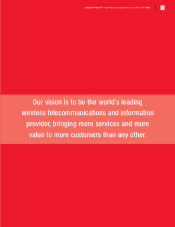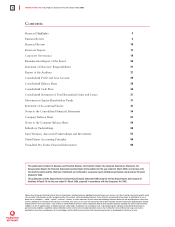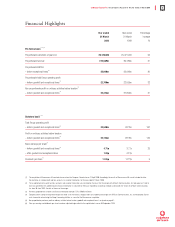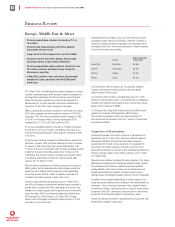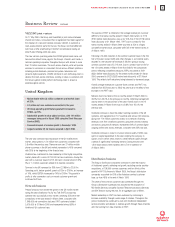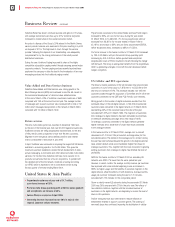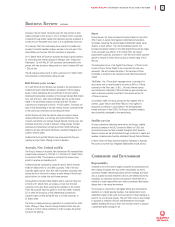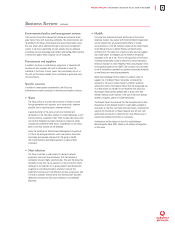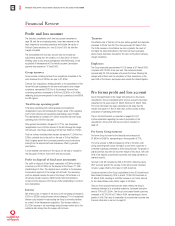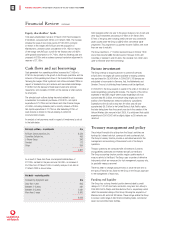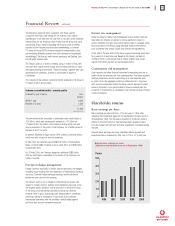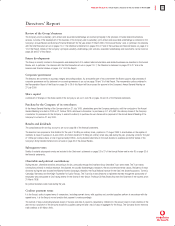Vodafone 2000 Annual Report Download - page 8
Download and view the complete annual report
Please find page 8 of the 2000 Vodafone annual report below. You can navigate through the pages in the report by either clicking on the pages listed below, or by using the keyword search tool below to find specific information within the annual report.
Vodafone AirTouch Plc Annual Report & Accounts for the year ended 31 March 2000
6
Business Review continued
Vodafone Retail has shown continued success and grew to 272 shops,
with average connections per shop up by 57%. Vodafone Corporate
increased its market share in the overall corporate market.
An option to dispose of the Group’s 20% interest in the Martin Dawes
service provider business was exercised in the year, resulting in a profit
on disposal of £11m. The high level of churn through this service
provider, following the disposal of our shareholding, was adequately
compensated for by the strong performance of the wholly-owned
distribution businesses.
During the year, Vodafone Paging improved its share of the highly
competitive subscription paging market through securing several major
corporate contracts. The new paging services recently launched have
positioned the company to take the lead in the introduction of two-way
messaging services into the traditional paging market.
Value Added and Data Services business
Vodafone Value Added and Data Services saw strong growth in the
Short Message Service (SMS) and continued to lead the UK market in
the commercial development of data and value added services.
At the end of March, 43% of Vodafone’s customers made use of SMS,
compared with 15% at the same time last year. The average number
of messages sent by each customer also increased with a total of 141
million short messages being carried on the network in March 2000,
compared with 15 million in March 1999.
Future services
The UK’s multi-media portal was launched in December 1999 and,
by the end of the financial year, had over 60,000 registered customers.
Additional services are being progressively launched and, by the end
of May, the UK portal is expected to have over 90,000 customers.
Migration to the new global service delivery platform and Internet
brand is anticipated to take place in July 2000.
In April, Vodafone was successful in acquiring the largest UK 3G licence
available to an existing operator, for £5.964 billion. This gives the
maximum spectrum available to enable the full development of video,
picture messaging, e-commerce and other data and mobile multi-media
services. For the first time, Vodafone will have more capacity for its
products and services than any of its UK competitors. In parallel with
the development of the 3G network, Vodafone is testing and rolling
out GPRS, which is expected to be in commercial service during
the last quarter of the year ending March 2001.
United States & Asia Pacific
•Proportionate customers at year end of 14.7 million,
a pro forma increase of 38%.
•Pro forma total Group operating profit of £915m before goodwill
and exceptionals, an increase of 45%.
•Verizon Wireless created on 3 April 2000.
•Ownership interests increased to over 20% in each of nine
regional Japanese cellular networks.
Proportionate customers for the United States and Asia Pacific region
increased by 38%, on a pro forma basis, during the year ended
31 March 2000, to 14,686,000. Pro forma proportionate turnover
increased from £3,807m for the year ended 31 March 1999 to
£5,187m, an increase of 36%, and pro forma proportionate EBITDA,
before exceptional items, increased by 38% to £1,522m.
Pro forma turnover in the twelve months to 31 March 2000 increased
by 19% to £3,956m, with pro forma total Group operating profit
increasing by 45% to £915m, before goodwill and exceptional
reorganisation costs of £30m incurred in the US following the merger
with AirTouch. The Group is seeing clear benefits from this expenditure,
which is generating synergies in line with the plan developed before
merger completion.
US Cellular and PCS operations
The Group’s mobile operations in the US increased total proportionate
customers on a pro forma basis by 1,873,000 to 10,553,000 at the
year end, an increase of 22%. This increase includes over 402,000
customers added through the acquisition of CommNet and 214,000 net
customers connected by the CMT and PCS PrimeCo joint ventures.
Strong growth in the number of digital customers resulted from the
continued rollout of the US digital network. 4,196,000 proportionate
customers were connected to the digital network at 31 March 2000,
representing 40% of the customer base at the end of the year,
compared with 22% at 31 March 1999. The migration of customers
from analogue to digital networks has been stimulated by incentives,
an extensive advertising campaign and a new range of tariffs.
On average, customers connected to the digital network generate
higher revenues and a lower level of churn than those connected
to the analogue network.
In the twelve months to 31 March 2000, average cost to connect
decreased to £141 from £145 (at constant exchange rates) for the
comparable period. The decline in the average cost to connect during
the year has been achieved despite the growth in the digital customer
base, where handset prices are considerably higher than those for
analogue customers. This, together with the costs incurred in migrating
existing customers from analogue to digital, has affected the level of
profitability.
ARPU for the twelve months to 31 March 2000 on subsidiary US
networks was £293, 7% lower than the same period last year.
However, in recent months, the average monthly revenue per customer
has improved with some markets beginning to see an increase in
ARPU, as higher usage, and the benefits of customer migration to the
digital network, offset the effects of tariff reductions. Average monthly
usage per customer increased during the year to 141 minutes,
compared with 122 minutes for the comparable period.
Churn on wholly owned US networks during the year ended 31 March
2000 was 29% compared with 27% in the prior year. The effects of
new retention initiatives, together with the increased number of
customers on the digital network, are beginning to reduce the level of
churn in US operations.
Positive measures have also been taken to reduce reliance on
independent retailers to support customer growth. The opening of
new retail shops has continued, improving the distribution of cellular



